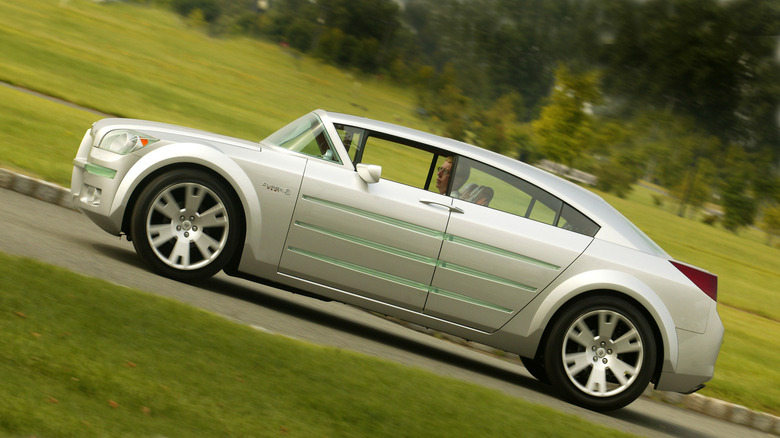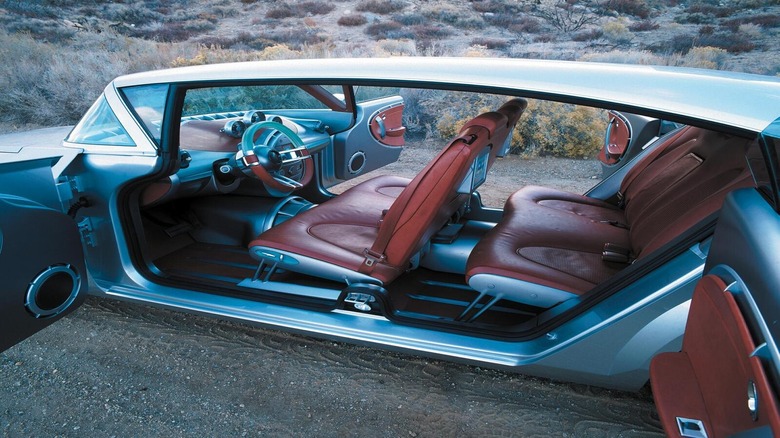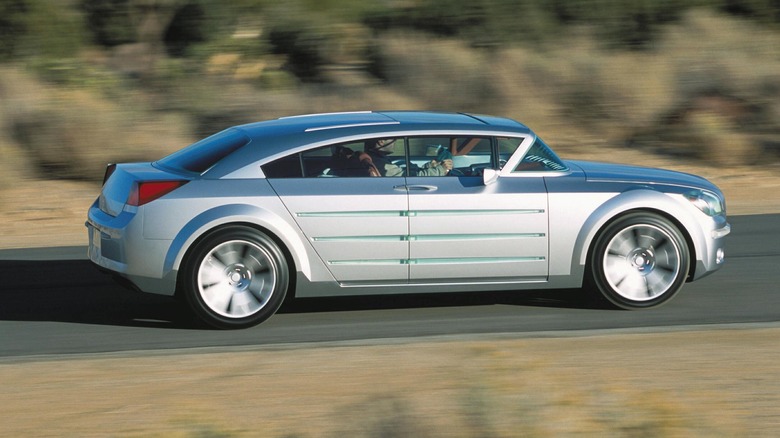The Bizarre Dodge Concept Car You'll Be Glad Never Made It To Market
American automaker Dodge made some pretty nifty concept cars back in the day. Before Hennessey created the Ram TRX Mammoth 6x6, Dodge had the T-Rex 6x6 Concept with six wheels and – you guessed it — six-wheel-drive. And before we got amazed by the Challenger SRT Demon, Dodge came up with the Demon concept in 2007, a roadster with a rear-wheel-drive (RWD) platform, a manual gearbox, and a 172-horsepower four-cylinder engine.
Dodge came up with a new concept in 2001, which would herald the return of the automaker's legendary Hemi V8 engine. This new concept vehicle marked the revival of the all-American luxury sedan with V8 muscle under the hood and a rear-wheel drivetrain. From a Mopar fan's perspective, it all sounded exciting: a muscle car with four doors, five seats, and trunk space, surefire ingredients of a potential hit.
But as the curtains lifted at the 2001 North American International Auto Show (NAIAS) in Detroit, the viewing public got their first taste of the Dodge Super8 Hemi Concept, the brand's future American car. Admittedly, the Super8 Hemi's design is an acquired taste, but it did mark the beginning of a new era for Dodge.
Dodge Super8 Hemi Concept: It's what's inside that counts
The concept behind the Dodge Super8 Hemi's oddball shape was the brand's then-new "Passenger Priority Design" idiom, offering panoramic views of the outside world for each passenger. The rear seats were higher than the front, affording rear occupants a theater-like view of the road.
Furthermore, the truck-like features of the body panels gave it a bolder and more tangible expression, while the rear suicide doors add an exotic look to the entire shape. This car was meant to embody "the culture and essence of American optimism," according to Freeman Thomas, Daimler-Chrysler vice president of advanced design strategy, in a 2001 press release.
The Dodge Super8 Hemi's in-your-face design had its fair share of detractors. Some say it's one of the weirdest concepts ever produced with its forward-canted windshield, awkwardly sloping roof, bold grille design, and chrome side strakes. Others were kinder and called it "amazing," primarily due to the concept's rear-wheel drivetrain and potent Hemi V8 engine.
But then again, the then-bizarre design of the Dodge Super8 opened the doors to Dodge's legendary LX cars that underpin the Chrysler 300, Dodge Challenger, and Dodge Charger. Thankfully, the LX lineup didn't inherit the Super8's weird yet futuristic windshield and googly face. Still, the concept's slab side panels and bulging wheel arches are familiar to modern muscle car fans.
Space, pace, and grace
As revealed in the original press release, the gaping maw of the Super 8 Hemi Concept was a new 5.7-liter V8 engine with 353 horsepower and 395 pound-feet of torque. The revised Hemi engine had an overhead valve (OVH) design, aluminum heads, and a cast-iron block. It sent grunt to the rear wheels using a four-speed automatic transmission, helping it scamper from zero to 60 mph in under six seconds, with a 154 mph top speed.
The burly engine is a given, but it also had front MacPherson struts with billet-aluminum control arms and a custom five-link rear independent suspension with coil-over shocks to deliver sharper handling. It also has a ridiculously long wheelbase, a lowered ride height, and 22-inch wheels, providing a vibe Motortrend described as "phat."
On the other hand, the Super8 Hemi's interior triumphs retro-modern design with jukebox-inspired, center-mounted gauges, brushed/painted aluminum trim, and fine leather upholstery. It also has a bespoke "Infotronic System" with an LCD-controlled internet-enabled interface before the internet became this huge thing, a precursor to modern infotainment systems and display screens in modern cars.
In our mind, the Dodge Super8 Hemi Concept was ahead of its time, and people weren't ready for a family sedan appearing to be inspired by the slab-sided design of a truck (never mind those strange reversed A-pillars and canted roof). Thankfully, Dodge designers awoke from their auto show slumber and gave the Chrysler 300, Dodge Challenger, and Dodge Charger a proper windshield (and roof) without altering the vehicle's muscular stance.


